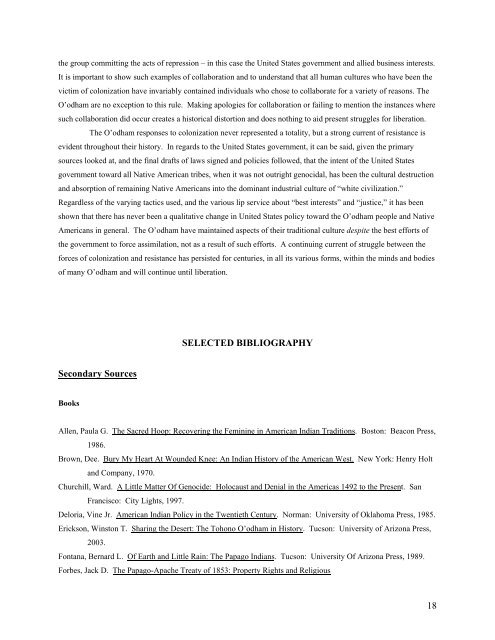Resistance and Collaboration: O'odham Responses to U.S. Invasion
Resistance and Collaboration: O'odham Responses to U.S. Invasion
Resistance and Collaboration: O'odham Responses to U.S. Invasion
You also want an ePaper? Increase the reach of your titles
YUMPU automatically turns print PDFs into web optimized ePapers that Google loves.
the group committing the acts of repression – in this case the United States government <strong>and</strong> allied business interests.<br />
It is important <strong>to</strong> show such examples of collaboration <strong>and</strong> <strong>to</strong> underst<strong>and</strong> that all human cultures who have been the<br />
victim of colonization have invariably contained individuals who chose <strong>to</strong> collaborate for a variety of reasons. The<br />
O’odham are no exception <strong>to</strong> this rule. Making apologies for collaboration or failing <strong>to</strong> mention the instances where<br />
such collaboration did occur creates a his<strong>to</strong>rical dis<strong>to</strong>rtion <strong>and</strong> does nothing <strong>to</strong> aid present struggles for liberation.<br />
The O’odham responses <strong>to</strong> colonization never represented a <strong>to</strong>tality, but a strong current of resistance is<br />
evident throughout their his<strong>to</strong>ry. In regards <strong>to</strong> the United States government, it can be said, given the primary<br />
sources looked at, <strong>and</strong> the final drafts of laws signed <strong>and</strong> policies followed, that the intent of the United States<br />
government <strong>to</strong>ward all Native American tribes, when it was not outright genocidal, has been the cultural destruction<br />
<strong>and</strong> absorption of remaining Native Americans in<strong>to</strong> the dominant industrial culture of “white civilization.”<br />
Regardless of the varying tactics used, <strong>and</strong> the various lip service about “best interests” <strong>and</strong> “justice,” it has been<br />
shown that there has never been a qualitative change in United States policy <strong>to</strong>ward the O’odham people <strong>and</strong> Native<br />
Americans in general. The O’odham have maintained aspects of their traditional culture despite the best efforts of<br />
the government <strong>to</strong> force assimilation, not as a result of such efforts. A continuing current of struggle between the<br />
forces of colonization <strong>and</strong> resistance has persisted for centuries, in all its various forms, within the minds <strong>and</strong> bodies<br />
of many O’odham <strong>and</strong> will continue until liberation.<br />
SELECTED BIBLIOGRAPHY<br />
Secondary Sources<br />
Books<br />
Allen, Paula G. The Sacred Hoop: Recovering the Feminine in American Indian Traditions. Bos<strong>to</strong>n: Beacon Press,<br />
1986.<br />
Brown, Dee. Bury My Heart At Wounded Knee: An Indian His<strong>to</strong>ry of the American West. New York: Henry Holt<br />
<strong>and</strong> Company, 1970.<br />
Churchill, Ward. A Little Matter Of Genocide: Holocaust <strong>and</strong> Denial in the Americas 1492 <strong>to</strong> the Present. San<br />
Francisco: City Lights, 1997.<br />
Deloria, Vine Jr. American Indian Policy in the Twentieth Century. Norman: University of Oklahoma Press, 1985.<br />
Erickson, Wins<strong>to</strong>n T. Sharing the Desert: The Tohono O’odham in His<strong>to</strong>ry. Tucson: University of Arizona Press,<br />
2003.<br />
Fontana, Bernard L. Of Earth <strong>and</strong> Little Rain: The Papago Indians. Tucson: University Of Arizona Press, 1989.<br />
Forbes, Jack D. The Papago-Apache Treaty of 1853: Property Rights <strong>and</strong> Religious<br />
18


